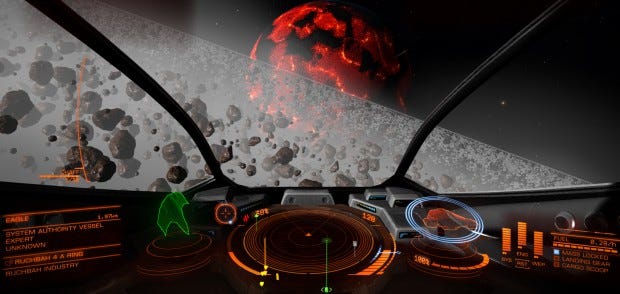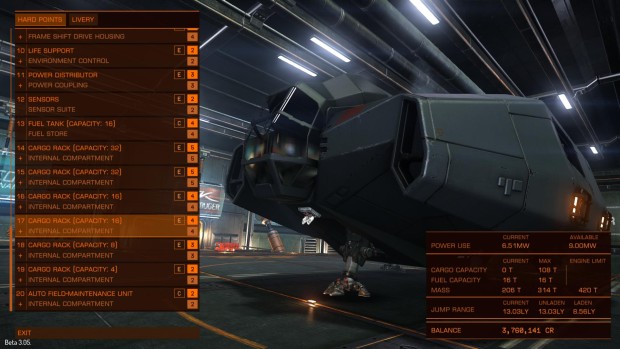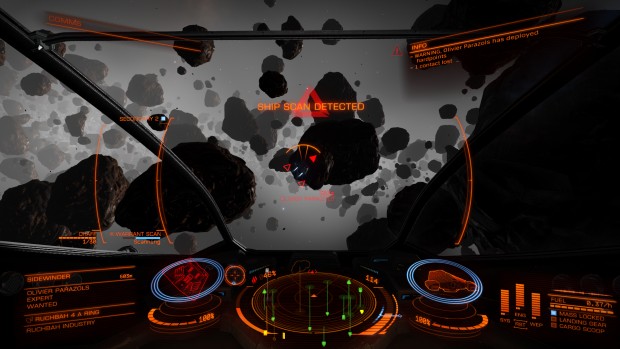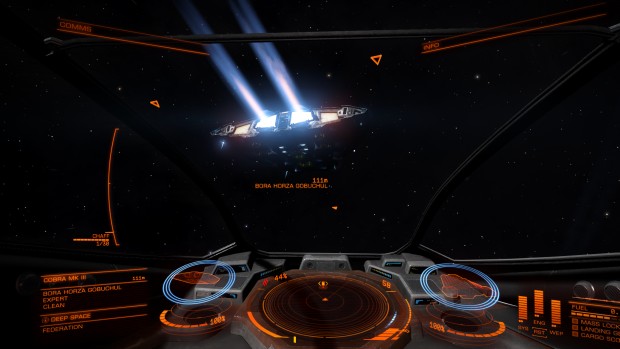Wot I Think - Elite: Dangerous Review
Going Deep On Deep Space
Elite: Dangerous is a big game. It is big because it offers an uncharted galaxy of 400 billion stars to roam around. It is big because its bloodline comes from of one of gaming’s most respected sims. And it is big because it has the ambition of an interstellar Macbeth, backed by over £1.5 million in crowdfunding cash. When Pip asked me in her audio feature what I thought of the game, I responded: “I don’t envy the person who has to review it.” As it turns out, that’s me. So here we go. A big review for a big game. Here’s Wot I Think.
Small Beginnings
You begin with a small ship and a meagre handful of credits. The idea is that you are to become a pilot of repute (ill-repute or otherwise, that’s up to you) and slowly begin accruing more capital. this leads to bigger ships, larger cargo bays to store more goods and fiercer lasers to gun down more criminals. But before any of that you will need to learn how to pilot your Sidewinder into a docking bay without crashing into a wall. These first few hours with your vessel are probably the most enjoyable of the game. There are enough moments of “I wonder what this switch does? Oh no oh no oh n--” to satisfy that unending (dangerous) curiosity all gamers secretly harbour for Big Red Buttons. The humour and panic are multiplied many times for anyone playing with a joystick or Hotas, the key bindings procedure offering that quiet thrill of making a complicated machine work in exactly the way you want it to. Even if it is not a sim in the Tim Stone sense, there is still enough complexity to the controls to keep you learning well after you earn your first paycheck. I only learned yesterday, for example, that you can manually extend and retract the scale of your sensors, leading me to tap the ‘Page Up’ and ‘Page Down’ keys and giggling like a child as the relevant HUD icon corresponded to my taps. It's small details like this that make simply learning your way around the cockpit Elite’s first great “feature”.
Once you’ve got the basics down (let’s see, docking, lateral thrusters, landing gear, oh wait sorry that’s pulse lasers, how do I, maybe this, oh no that’s my afterburner, oh god, sorry sorry sorry) you still need to figure a lot out. Unfortunately, what will give one person the sense of discovering how a new toy works will only give another a sense of frustration. In a lot of ways, the game does not try very hard to explain itself to the player. Early on, outfitting your ship is an obscurantist process of adding things and seeing if numbers go blue or red, without necessarily knowing what any of them mean. The system is smart once you understand it but it isn’t explained to you at all. Each component, from mining laser to chaff launcher, has a class and a rating, but will also have various other stats and features that aren’t always detailed when you buy them. For example, a Shield Cell Bank is a device that quickly recharges your shield in the middle of a fight. The outfitting menu will tell you the cost, the rating and the power draw of this device but not how many “charges” it can hold (how many times you can use it). Other components are equally confusing. Generally, the closer to an A rating a piece of equipment is, the better and if you’re unhappy you can sell back any piece of equipment for the same price you bought it. But it still takes time and a lot of trial and error to figure out what goes best with your loadout.
But enough about what goes on in the garage. This is a space sim, you want to see some space. This is one element of the game that doesn’t disappoint. These are some of the most stunning vistas I have seen in a game. Words, even still images, cannot do justice to sighting a blue star shining through the mists of a planet’s ring, as you slowly navigate around the belt’s spinning asteroids. Or the golden, sun-drenched landing bay of an unsanctioned outpost, hanging above a barren rock world. Or the light of every star in front of you warping into a surreal sphere as you tentatively approach the event horizon of an invisible black hole. These visual smorgasbords are accompanied by incredible sound design. The echo of a space station’s barrel-like interior, the voice of your on-board computer distorting when you come under attack, the thrusters whining as you slam the afterburner to get away. Forget that space is a vacuum and oughtn’t to actually have sound and just focus on how each engine is subtly but noticeably different for each ship. For a long time, simply flying is a joy. One of my favourite memories was discovering one of the game’s few capital ships as it orbited Earth and zooming through a hollow passage within its structure and out the other side, like some cosmic hollywood stuntman.
An Open World
However, as big games have too often taught us, a big world is only as interesting as the people and events which inhabit it. This is a weak spot for E:D. The missions you rely on to make your first few thousand spacebucks are MMO-like in the extreme and only boil down to three tasks: find, deliver, kill. The text that accompanies these missions is repetitive and uninspired, as if there was one person in the galaxy responsible for every bulletin, who sits doodling between mission statements, indescribably bored. Anyway, you quickly stop reading them and simply get on with the mission as stated in the ‘headline’. As some have pointed out, these missions are really only things to get your noggin whirring. The real appeal comes in making your own way. Frontier’s marketing spiel has been pumping out this very sentiment for a while now (be a pirate! be a miner! be an explorer!) and, while I hate to back up any spiel, it is true. In the new Elite, “Blaze your own trail!” is less of a suggestion than it is a necessity. Although a more accurate tag line would probably be: “Blaze one of these five trails!”
I have had a go at each career and they all have their own appeal. Getting yourself a big cargo hold and finding a strong trade route is the most lucrative by a long shot and not so dull as you might imagine (at least, not for the first couple of million credits - more on that later). But it also requires a lot of money to do right, as well as a big investment in a big ship and new parts to jump long distances across the stars. Find a rare good, like the bafflingly-named drug ‘Onionhead’ or the delicious spirit of our nearest solar neighbour ‘Centauri Mega Gin’ and you will be able to hawk these for a huge profit. But only if you sell it in a system about 150 light years away. Even then, you will need to make sure what you are selling is not considered illegal, as transporting prohibited goods into a station where they are forbidden is only one routine scan away from getting you boiled alive by the space cops’ laser fire, whereupon your spunky little trading vessel will burst, like a eyeball popping under the heel of a jackboot.
Jobseeking
That isn’t the only thing you have to think about. There is a moment in every trader’s career when they look at their ship and wonder if it is worth stripping the shields off and replacing them with extra cargo bays. Designing the game so that both these components need to go in the same slot type is the perfect example of Elite at its most intelligent. It requires you to make a risk/reward decision that may not have ramifications for days or weeks, possibly never. Go without shields and you are vulnerable to instant vapourisation, losing your entire cargo and the profit it could have made. Keep the shields and you could be losing out on carrying another 16 or 32 tonnes per run. Although this is a bonus profit not to be sniffed at, such greed can be a pilot’s undoing. I strongly advise you to keep your shields.
Exploring, like many paths, is less profitable but it does break the monotony of ‘mission stacking’ or back and forth journeys after you have been doing a lot of trade runs, especially if you set something interesting as a destination, like a system with a black hole, or one in the middle of a cloudy nebula. It works like this: you kit out a ship with a good Frame Shift Drive (the warp engine), a discovery scanner and a surface scanner. I used an Adder, which is essentially a space hatchback. Star systems coloured grey on your galaxy map are always marked as unexplored for you, even if another person has been there. You jump from system to system, using your scanners on the main star and any other planets you discover. When you get back to populated space you can sell this data in any station. Some discoveries pay better than others. Scans of a rocky planet will only earn you measly pennies but an Earth-like planet will get you thousands.
Data on a black hole, however, can fetch a hefty 20,000 credits, so when a friend and I went on a road trip and discovered a system with two black holes and a magnificent white giant, it was not only a great excuse to nerd out about space but also a relief to come back to our “home system” after the day’s jaunt and find out we had at least made hundreds of thousands of credits from the journey.
Whatever your reasoning, exploring is certainly the best way to get a feel for the vastness offered in the game and to see how much work has gone into replicating the known galaxy. Stars are categorised by type and reproduced here in stunning form, some spinning so fast you can see the flares twisting and wavering as you approach. But exploration has its own risks. When you jump into a system and see a tiny neutron star, do not be fooled by its adorable smallness. It is a superheated monster and will fry you up in moments if you even get a little too close. Likewise, any explorer will need to have a fuel scoop fitted, so they can refuel far away from the hustle and bustle of busy space. This itself is a dangerous job, as you have to orbit close to a sun, absorbing energy for fuel, all the while watching your ship’s temperature. Some stars, you will learn, it is impossible to refuel at, since they are too hot or too cold. You always need to watch that fuel gauge. Dying because you ran out of gas in the middle of space-nowhere is one of the saddest and loneliest ways to go. Left without companions or pitstops, you are left no choice but to kill yourself. Turn off life support, hit the self-destruct button, dive into the sun - your choice. But whichever way you go, all your exploration data goes with it. A harsh lesson to learn. But something you won’t have to be taught twice.
Piracy And Combat
Piracy and bounty-hunting are options for the war-like. The latter is a somewhat laid-back combat role, one that is fairly easy for beginners to get involved in. A Kill Warrant scanner and a bevy of guns is all you need. Then head to a Nav Beacon orbiting a nearby star, or better yet a ‘Resource Extraction Point’ (where miners laser metal-rich asteroids for their goodies, at such a pitiful rate and in such a boring way that I am not even going to go into mining in detail itself). These places harbour Wanted criminals, who you can kill for their bounty. Some have a higher price on their heads than others but, provided you are not smoked by your foes, there is a great cash flow to be had in this, especially early in the game.
Piracy is much more tricky. You can fit your ship with an ‘Interdictor’, a device that pulls other ships out of supercruise (the mid-gear warp you use to travel between planets and stations within a system) and sail the space lanes in search of a Type-6 with a cargo full of expensive Palladium. There is a lot of fun to be had in mastering piracy and this career has all the creepiest toys. For example, a cargo scanner for peeping into your quarry’s hold, and limpet drones that attach to their hull and force the cargo hatch open, ejecting the sweet cannisters of loot one after another into the transporter’s wake, like shiny droppings.
It is a credit to the ship design of the game that some vessels are clearly designed for certain tasks, while others can be adapted.The Lakon range are a group of transporters that handle stiffly but can manage huge holds and jump massive distances - the hardy trucks of the galaxy. The Viper is a speedy and powerful vehicle that can chase down almost any prey, perfect for bounty hunting. The Cobra Mk III, on the other hand, is a mid-sized ship that is a favourite for pirates because, while brandishing a horrible collection of weapons, it also has space in its belly to store a sizeable amount of stolen goods. It is like being mugged by a marsupial with really sharp teeth. For a long time, I considered the Cobra a nasty ship and one unbefitting a cargo haulier. But looking at it more closely, it can easily be retrofitted so that it carries more than the basic spacetrucks, netting any trader a decent bit of dough per trip. Further up the scale the ships get bigger, badder and more intense but they are also way more expensive, leading to another unfortunate weakness of the game. The grind.
There was a time for me (as I have mentioned before) when playing became a chore. The progression from ship to ship is arguably what drives the entire game. The end goal, as I see it, is to have a personal garage with every ship specced out in the way you like it, or at least to have taken everything for a spin at least once. This progression from ship to ship begins quickly enough, especially when you trade in your last vessel for a marked down price on a shiny new one. But there comes a time when you discover that the rungs of this ladder are suddenly placed too far apart to climb. Grinding missions, bounties or trade runs to gain money becomes less meaningful and less interesting the further you are from achieving your next goal. When I begin to sigh in a game, that is when I begin to recognise the cogs behind the screen. The grind gets me wondering: what is this game even about? Why am I doing MMO quests to shoot down another Big Boss? Didn’t Frontier say something about this being a responsive, dynamic world, driven by and reacting to us, the players? Because, now that I think about it, I have not seen any of that.
A Flawed Frontier
The player-populated universe is clearly intended to be a major selling point here. In worlds like Eve: Online the players make up for any lack of developer-led narrative (ie. boring MMO missions) with their own power struggles, machinations and galactic conflicts. Unfortunately, there hasn’t been much player-on-player action in all my time playing, despite actively seeking it out. Conflict zones, where players can join NPC factions as they vie for control in a spacey dogfight, are the only place I have seen people interacting - and even then it is simply to destroy one another. Although tales of piracy, hold-ups, blockades and revenge attacks sometimes appear on the game’s Reddit, I was sad to see so little of it myself. Still, I was not entirely surprised, considering there is no infrastructure for organising large clans and that the communications system is fiddly, unresponsive and sometimes just plain broken.
In fact, the closer you look at Elite, the more the flaws become evident. It is like looking at the earth from afar. Oh wow, what a sight. Beautiful, moving, inspiring. I think I am catching Overview Effect. But when you get in close you can see the piles of rubbish building up in the landfills, the oil spilling out over the Mexican bay. The number of things that simply malfunction is staggering.
Here are some bugs I have encountered.
- Bounty rewards not being honoured (ie. not receiving my space paycheck)
- Being stuck in warp indefinitely
- Being unable to press any buttons on the menu
- Mouse cursor disappearing on starport menus
- Text of Mission titles reading things like “Deliver goods to $##DestinationStationName;”
- Ship’s computer consistently announcing ‘Landing gear not deployed’ when the landing gear is fully, undeniably, unmistakably deployed.
- NPCs broadcasting blank messages
- NPCs broadcasting under blank aliases
- NPCs mining empty space
- NPCs going round in tight, slow barrel rolls endlessly for no reason at all
- NPCs stealing kills from me (lost a 150,000 credit bounty thanks to this one)
- Being fired on by friendlies in conflict zones
- Being given a bounty for attacking ships marked as enemies in conflict zones
- Missions not registering kills
- 10 floating cargo cannisters vanishing into thin air, shortly after being dropped
- Friends not appearing in the same instance
- Friends not receiving communications messages
- Friends’ messages not being received by me
- Etc
- Etc
- Oh God
- Etc
Now, it is evident from my hundreds of hours in the cockpit, as well as a space diary of about 14,000 words, that I love Elite: Dangerous. But love is complicated, because while I think it is excellent, I also think it is obviously incomplete. And I don’t mean incomplete as in: “Psshh, they haven’t added planet landing yet.” I mean incomplete as in: “Psshh, they have not adequately tested this game.”
Things like the above may not annoy you so much. And if that is the case, fire away, you will have an excellent time. But for me, it is clear that the game has not been given the amount of polish it deserves, nor does it seem to have even covered all the basics. For instance, friends playing side by side, even if they lucky enough to be placed in the same instance, cannot share bounty rewards if they go pirate stomping together. They cannot transfer money from one person to another. Nor can they share missions in any meaningful way. A pity, since the more challenging missions involve hunting down and killing larger ships like Anacondas - something that would be impossible for a fresh-faced fighter but thrilling if a bunch of newbies were to take on the monster together. Imagine seeing that 160,000 credit reward, rounding up a small posse and going out to bring down a ship much bigger and scarier than any of you. Sounds good, right? But no, you can’t do this. An update titled ‘Wings’ is planned to add a lot of these features some time early this year but it is hard to get too excited for something that should have been included in the first place.
Massively Multiplayer Misadventures
Why Frontier rushed this out before Christmas when many of the features vital to a multiplayer game remained unfinished is a complete puzzle, but whatever the reason, it's a move that may prove woefully misjudged. It means that many people’s first impressions are of a brilliant game, but one that is incomplete and riddled with infuriating gremlins. For example, the holiday period included, for many, a server-side malfunction that left folks either losing hundreds of tonnes of cargo or being given billions of credits compensation by mistake. Not only is this straight-up bad in terms of enjoying your time in space, it also has ridiculous economic implications. Some of the luckier beneficiaries of these errors have been buying Palladium - an expensive metal - and flushing the cargo into space for their fellow players, effectively flooding the galaxy with freshly-printed creds, like a chaotic millionaire sprinkling banknotes from his skyscraper apartment.
I was playing with a friend in a different part of space when this same server maelstrom passed over the galaxy. And at the risk of sounding like an Upworthy headline, what happened next was lunacy. My pal parked his transport ship, full of cargo, and bought a smaller Viper as an extra to try out. In the meantime, the game pulled a wobbler and when he sought to retrieve his cargo ship he discovered that, not only had the ship been mysteriously warped to a system 15 light years away, but the station it was being held in did not even have a shipyard. Without this option in the starport menu, his ship was impossible to get back. The game had essentially towed him. At time of writing, he is still waiting for his ticket to technical support to be sorted out.
Stories like this are a huge pity. They give a great game a bad reputation. But from what I have myself experienced, it is a deserved reputation. Most of the time, Elite works. The excitement, even the boredom, of the game is still preserved for me as something I am happy to have paid for. But it would be a poor reviewer indeed who did not mention that the sim’s rough edges have not been satisfactorily sanded down. I would be equally naive if I did not suspect that the Kickstarter mentality of constant development (“we can fix that later in a patch”) is partly to blame. All this means is that the game being sold on Frontier’s website does not feel like Elite 1.0. It still feels like Elite 0.9.
The visual splendour of the galaxy is recreated wonderfully, the feel and look of the ships make piloting and dogfighting a joy, and even the limited spread of occupations, from explorer to smuggler, gives you enough to play around with. The game is at its finest when you set your own challenges: pirate a Type-9, reach the Horsehead Nebula, smuggle slaves into a Federation port. If, hearing these possibilities, you can already see yourself flipping switches and tenderly pressing buttons on a flight stick, then I have no problem recommending it to you. I just feel everyone should be aware of what they’re getting when they buy Elite. The best unfinished game of last year.





















